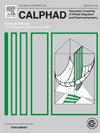BCC_B2相在Ni-Ti-Fe三元体系中的扩散行为
IF 1.9
3区 材料科学
Q4 CHEMISTRY, PHYSICAL
Calphad-computer Coupling of Phase Diagrams and Thermochemistry
Pub Date : 2025-10-18
DOI:10.1016/j.calphad.2025.102890
引用次数: 0
摘要
Ni-Ti-Fe形状记忆合金BCC_B2相扩散系数的高通量测定为相场建模、DICTRA模拟和icme引导合金设计等多物理场模拟提供了必要的输入参数。本研究制备了11组扩散偶,分别在1223 K、1273 K和1323 K下退火60 h、48 h和36 h。采用电子探针显微分析测量了扩散界面处的成分-距离分布。采用数值反演方法提取了相互扩散系数,并与传统的高精度Matano-Kirkaldy方法进行了比较。两种方法的结果具有较强的一致性。建立了成分相关和距离相关的互扩散系数。基于Arrhenius方程,分析了频率因子和活化能随组分的变化规律。这些结果为Ni-Ti-Fe体系的扩散行为提供了全面的见解,为动力学建模和合金优化提供了关键数据。本文章由计算机程序翻译,如有差异,请以英文原文为准。
Diffusion behaviors of BCC_B2 phase in Ni-Ti-Fe ternary system
High-throughput determination of the diffusion coefficients in the BCC_B2 phase of Ni-Ti-Fe shape memory alloys provides essential input parameters for multiphysics simulations, such as phase-field modeling, DICTRA simulations, and ICME-guided alloy design. In this study, 11 sets of diffusion couples were prepared and annealed at 1223 K, 1273 K, and 1323 K for 60 h,48 h, and 36 h, respectively. Composition-distance profiles at the diffusion interfaces were measured by Electron Probe Microanalysis. Interdiffusion coefficients were extracted via numerical inverse method, and the results were compared with those obtained by the traditional high-accuracy Matano–Kirkaldy method. The results of the two methods show strong consistency. Both composition-dependent and distance-dependent interdiffusion coefficients were established. Furthermore, the composition-dependent variations of the frequency factor and activation energy was evaluated based on the Arrhenius equation. These results offer a comprehensive insight into the diffusion behavior of the Ni-Ti-Fe system, providing critical data for kinetic modeling and alloy optimization.
求助全文
通过发布文献求助,成功后即可免费获取论文全文。
去求助
来源期刊
CiteScore
4.00
自引率
16.70%
发文量
94
审稿时长
2.5 months
期刊介绍:
The design of industrial processes requires reliable thermodynamic data. CALPHAD (Computer Coupling of Phase Diagrams and Thermochemistry) aims to promote computational thermodynamics through development of models to represent thermodynamic properties for various phases which permit prediction of properties of multicomponent systems from those of binary and ternary subsystems, critical assessment of data and their incorporation into self-consistent databases, development of software to optimize and derive thermodynamic parameters and the development and use of databanks for calculations to improve understanding of various industrial and technological processes. This work is disseminated through the CALPHAD journal and its annual conference.

 求助内容:
求助内容: 应助结果提醒方式:
应助结果提醒方式:


